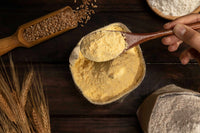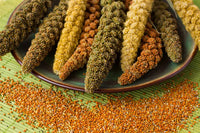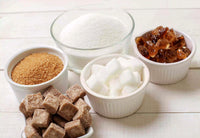Millet, a small-seeded grass, has been cultivated for centuries worldwide and is a staple food in many countries, particularly Africa and Asia. Its growing popularity in the Western world is due to its many health benefits. Being gluten-free grains, these are packed with essential nutrients that promote overall health and well-being. Millets are a cereal grain belonging to the Poaceae family, along with rice and wheat, and is grown in various environments, ranging from arid to high rainfall areas. It is an annual crop that matures quickly and is known for its high drought tolerance, making it a preferred crop in regions where water is scarce. Here, we will explore the various types, health benefits, and tips for using millet.
Types Of Millet
Here are five of the most popular types of millet:
1. Kodo Millet
Kodo millet, a gluten-free and nutrient-rich grain, has been used as a staple food in many parts of India for centuries. It's an excellent source of dietary fibre, protein, and antioxidants. Also, it contains essential minerals such as calcium, iron, and potassium. It is also rich in B vitamins, particularly B6 and niacin. Kodo millet is thought to offer cooling effects in Ayurveda medicine that can help reduce inflammation and treat ailments, including fever and diarrhoea. It is used to improve digestion and strengthen the immune system.
2. Little Millet
Little millet, also known as Kutki or Samai, is a small-grain cereal native to India. It is an annual plant that is cultivated in dry regions. It is a gluten-free grain and a rich source of nutrients, making it an ideal food for those looking for a healthy substitute for rice. This grain is known for its immune-boosting properties due to the presence of antioxidants. Its low glycemic index makes it an excellent food for people with diabetes.
3. Browntop Millet
Browntop millet, also known as korale. It is a minor grain crop mainly grown in Asia, Africa, and the Americas. It is a small-seeded grass rich in protein, dietary fibre, and essential minerals such as iron, calcium, and magnesium. The grain has several health benefits, such as improving digestion, regulating blood sugar levels, and promoting cardiovascular health. It contains phytochemicals and antioxidants that protect against oxidative stress and inflammation linked to various chronic diseases.
4. Foxtail Millet
Foxtail millet is a popular staple food in many parts of India. It is also gaining popularity worldwide due to its many health benefits, such as helping prevent cell damage and anaemia and reducing the risk of chronic diseases. Foxtail millet is an excellent source of protein, fibre, vitamins, and minerals. It is also low in glycemic index, making it an ideal food for people with diabetes.
5. Barnyard Millet
Barnyard millet, or Echinochloa frumentacea, is a gluten-free ancient cereal grain. It is grown in many parts of Asia, including India, China, Japan, and Korea. The grain is highly valued for its nutritional content and is a rich protein, dietary fibre, and micronutrient source. It is an important food crop for people in regions where other cereals do not grow well, as it can tolerate high temperatures, drought, and low soil fertility.
Health Benefits Of Millet
1. Improves Digestive Health
Millet is high in fibre, which makes it an excellent food for promoting digestive health. Fibre helps to keep the digestive system moving and prevents constipation. Additionally, it is a prebiotic food that promotes the growth of beneficial gut bacteria.
2. Helps With Weight Management
Millet is a low-calorie food rich in fibre, making it an excellent food for weight management. The fibre content in grain helps keep you full for extended periods, reducing the need for snacking and overeating.
3. Prevents Anemia
The consumption of millet can help avoid anaemia. It contains a lot of iron necessary to develop red blood cells. Due to a deficit in iron in the body, iron deficiency anaemia is a prevalent disorder. This can lead to fatigue, weakness, and poor immunity. Consuming millet regularly can help prevent this condition and promote healthy blood circulation.
4. Promotes Skin Health
Millet is rich in vitamin B6, which is essential for healthy skin. Vitamin B6 helps in the production of collagen, a protein that is important for skin elasticity. Collagen gives the skin its firmness and prevents sagging and wrinkles. Eating millet regularly can assist in encouraging good skin and delay the signs of ageing.
5. Lowers Cholesterol
Millets are rich in soluble fibre, which helps reduce cholesterol absorption in the blood. High cholesterol levels in the body can increase the risk of heart disease and stroke. Consuming millet frequently can help lower cholesterol and the likelihood of developing these diseases.
Tips To Follow To Make The Most Of Your Millet
Follow these tips to ensure your dish turns out right and you get the most out of your millet.
Soaking millet overnight helps to break down the phytic acid, which impairs the absorption of minerals like iron, zinc, and calcium. By soaking millet, you can make them much easier on your stomach and aid digestion. So, remember to soak your millet overnight before cooking.
Cooking the grain is easy, but the key is to use enough water. Most people need clarification about the proportion of water to use. The general rule of thumb is to use eight times the water to the amount of millet you are cooking. Cook them until soft and fluffy, spoon out the excess scum that floats to the surface, and taste to ensure the grain is cooked. Also, retain the excess water to make millet 'Kanji,' a probiotic-rich drink!
It is recommended to use one variety of millet at a time as it is easier on the digestive system. Mixing different grains can force our bodies to deal with different constituents, making it harder for our digestive system to keep up.
Millets can increase 'Vaata', making them dry and hard to digest. Add a tadka with jeera and kadhi patta or a generous dollop of A2 cow ghee to your plate of millets. It enhances the taste of your dish.
Conclusion
Incorporating millet into your diet is an excellent way to promote overall health and well-being. Its high nutrient content, digestive benefits, and role in promoting heart health make it an ideal food choice. With a wide variety of millet types available, there are many ways to incorporate this grain into your diet, from soups to salads and main dishes. So, give millet a try and enjoy the many health benefits it has to offer.













